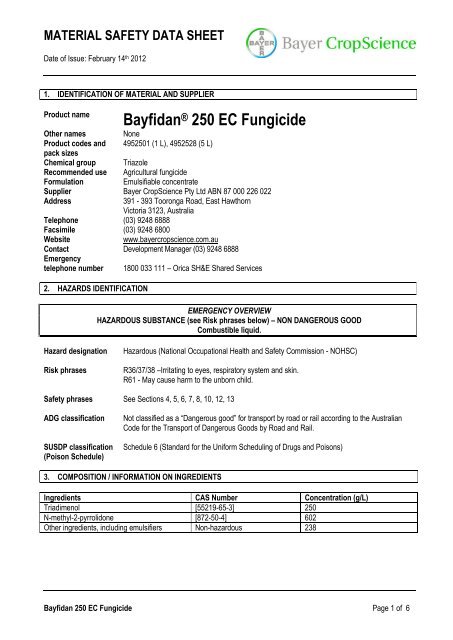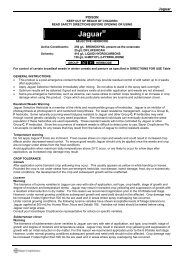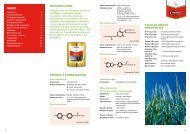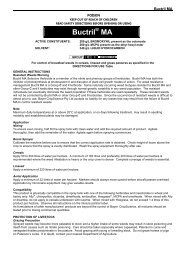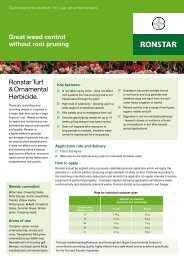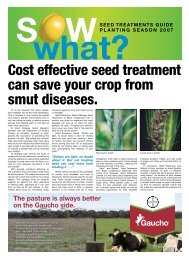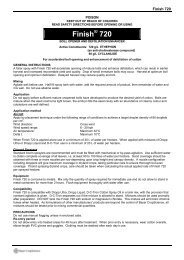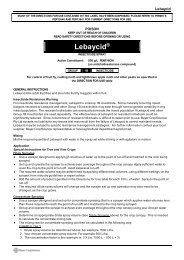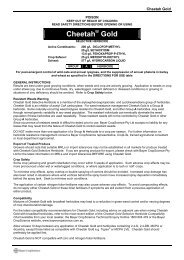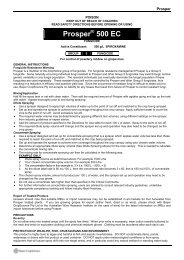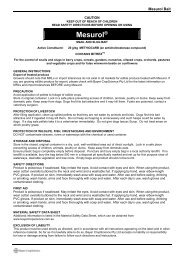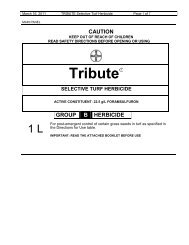Bayfidan® 250 EC Fungicide - Bayer CropScience
Bayfidan® 250 EC Fungicide - Bayer CropScience
Bayfidan® 250 EC Fungicide - Bayer CropScience
Create successful ePaper yourself
Turn your PDF publications into a flip-book with our unique Google optimized e-Paper software.
MATERIAL SAFETY DATA SHEET<br />
Date of Issue: February 14 th 2012<br />
1. IDENTIFICATION OF MATERIAL AND SUPPLIER<br />
Product name<br />
Bayfidan ® <strong>250</strong> <strong>EC</strong> <strong>Fungicide</strong><br />
Other names None<br />
Product codes and<br />
pack sizes<br />
495<strong>250</strong>1 (1 L), 4952528 (5 L)<br />
Chemical group Triazole<br />
Recommended use Agricultural fungicide<br />
Formulation Emulsifiable concentrate<br />
Supplier <strong>Bayer</strong> <strong>CropScience</strong> Pty Ltd ABN 87 000 226 022<br />
Address 391 - 393 Tooronga Road, East Hawthorn<br />
Victoria 3123, Australia<br />
Telephone (03) 9248 6888<br />
Facsimile (03) 9248 6800<br />
Website www.bayercropscience.com.au<br />
Contact<br />
Emergency<br />
Development Manager (03) 9248 6888<br />
telephone number 1800 033 111 – Orica SH&E Shared Services<br />
2. HAZARDS IDENTIFICATION<br />
EMERGENCY OVERVIEW<br />
HAZARDOUS SUBSTANCE (see Risk phrases below) – NON DANGEROUS GOOD<br />
Combustible liquid.<br />
Hazard designation Hazardous (National Occupational Health and Safety Commission - NOHSC)<br />
Risk phrases R36/37/38 –Irritating to eyes, respiratory system and skin.<br />
R61 - May cause harm to the unborn child.<br />
Safety phrases See Sections 4, 5, 6, 7, 8, 10, 12, 13<br />
ADG classification Not classified as a “Dangerous good” for transport by road or rail according to the Australian<br />
Code for the Transport of Dangerous Goods by Road and Rail.<br />
SUSDP classification<br />
(Poison Schedule)<br />
Schedule 6 (Standard for the Uniform Scheduling of Drugs and Poisons)<br />
3. COMPOSITION / INFORMATION ON INGREDIENTS<br />
Ingredients CAS Number Concentration (g/L)<br />
Triadimenol [55219-65-3] <strong>250</strong><br />
N-methyl-2-pyrrolidone [872-50-4] 602<br />
Other ingredients, including emulsifiers Non-hazardous 238<br />
Bayfidan <strong>250</strong> <strong>EC</strong> <strong>Fungicide</strong> Page 1 of 6
MATERIAL SAFETY DATA SHEET<br />
Date of Issue: February 14 th 2012<br />
4. FIRST AID MEASURES<br />
If poisoning occurs, immediately contact a doctor or Poisons Information Centre (telephone 13 11 26), and follow<br />
the advice given. Show this Material Safety Data Sheet to the doctor.<br />
Inhalation If inhaled, remove to fresh air and keep warm and at rest. Seek medical advice as above<br />
immediately.<br />
Skin contact Carefully remove contaminated clothing. Wash affected areas with soap and water. Seek<br />
medical advice if symptoms persist.<br />
Eye contact Rinse eyes immediately with clean lukewarm water for at least 15 minutes, holding eyes open.<br />
Consult an eye specialist.<br />
Ingestion Obtain immediate medical advice as above. If swallowed, do NOT induce vomiting. Rinse<br />
mouth and give a glass of water. Never give anything by mouth to a person who is<br />
unconscious or semi-conscious.<br />
First aid facilities Provide eye wash and safety shower in the workplace.<br />
Medical attention The product is an irritant. Triadimenol is a triazole compound. There are no cases of human<br />
poisonings published.<br />
Symptoms of exposure to N-methyl-2-pyrrolidone include headache, eye redness and pain,<br />
blurred vision. Ingestion causes gastric disturbances such as nausea and vomiting.<br />
Therapeutic measures: Basic aid, decontamination, symptomatic treatment.<br />
There is no antidote.<br />
Care should be taken to prevent pulmonary aspiration, as small amounts of liquid aspirated into<br />
the respiratory system during ingestion or from vomiting may cause bronchopneumonia or<br />
pulmonary oedema.<br />
5. FIRE FIGHTING MEASURES<br />
Extinguishing media<br />
Hazards from<br />
combustion products<br />
Precautions for fire<br />
fighters<br />
Hazchem code Not applicable<br />
Water spray, foam, carbon dioxide, sand, dry extinguishing powder.<br />
Can react with oxidising materials. In a fire, formation of hydrogen chloride, hydrogen cyanide,<br />
carbon monoxide and nitrogen oxides can be expected.<br />
The product is a combustible liquid. Vapours of N-methyl-2-pyrrolidone are heavier than air<br />
and can travel to an ignition source and flash back. Fire fighters should wear full protective<br />
gear, including self-contained breathing apparatus (AS/NZS 1715/1716). Keep unnecessary<br />
people away. If it can be done safely, remove intact containers from the fire. Otherwise, use<br />
water spray to cool them. Bund area with sand or earth to prevent contamination of drains or<br />
waterways. Dispose of fire control water or other extinguishing agent and spillage safely later.<br />
Do not release contaminated water into the environment.<br />
Bayfidan <strong>250</strong> <strong>EC</strong> <strong>Fungicide</strong> Page 2 of 6
MATERIAL SAFETY DATA SHEET<br />
Date of Issue: February 14 th 2012<br />
6. ACCIDENTAL RELEASE MEASURES<br />
Avoid contact with the spilled material or contaminated surfaces. Extinguish or remove any ignition sources. When<br />
dealing with spills do not eat, drink or smoke and wear protective clothing and equipment as described in Section 8 -<br />
PERSONAL PROT<strong>EC</strong>TION. Prevent spilled material from entering drains or watercourses. Contain spill and absorb with<br />
earth, sand, clay, or other absorbent material. Collect and store in properly labelled, sealed drums for safe disposal.<br />
Clean floor and all contaminated objects with damp cloth. Place used cleaning materials into the drum for disposal. Deal<br />
with all spillages immediately. If contamination of drains, streams, watercourses, etc. is unavoidable, warn the local water<br />
authority.<br />
7. HANDLING AND STORAGE<br />
Handling<br />
Keep out of reach of children. Will irritate the eyes and skin. Avoid contact with eyes and skin.<br />
Do not inhale spray mist. If product in eyes, wash it out immediately with water. After use and<br />
before eating, drinking or smoking, wash hands, arms and face thoroughly with soap and water.<br />
After each day's use, wash gloves, goggles and contaminated clothing. Keep away from ignition<br />
sources.<br />
Storage Store in the closed, original container in a dry, cool, well-ventilated area. Do not store for<br />
prolonged periods in direct sunlight.<br />
Flammability Combustible liquid Class C1 – flash point between 61 and 150° C<br />
8. EXPOSURE CONTROLS / PERSONAL PROT<strong>EC</strong>TION<br />
Exposure standards<br />
Biological limit<br />
values<br />
Engineering controls<br />
Personal protective<br />
equipment<br />
The NOHSC exposure standards for N-methyl-2-pyrrolidone are:<br />
TWA: 25 ppm (103 mg/m³); STEL: 75 ppm (309 mg/m³). Skin.<br />
Definitions:<br />
Exposure standard – Time Weighted Average (TWA) means the average airborne<br />
concentration of a particular substance when calculated over a normal eight-hour working day,<br />
for a five-day working week.<br />
Exposure standard – Short term exposure limit (STEL) means a 15 minute TWA exposure<br />
which should not be exceeded at any time during the working day.<br />
Skin notation – Absorption through the skin may be a significant source of exposure.<br />
None allocated.<br />
Control process conditions to avoid contact. Use in a well-ventilated area only.<br />
� Wear safety goggles.<br />
� Wear cotton overalls buttoned to the neck and wrist and a washable hat.<br />
� Wear elbow-length butyl rubber or neoprene gloves.<br />
� Wear an AS/NZS 1715/1716 approved respirator suitable for organic vapour/mist if<br />
exposure to vapours or mists is likely or ventilation is inadequate.<br />
Bayfidan <strong>250</strong> <strong>EC</strong> <strong>Fungicide</strong> Page 3 of 6
MATERIAL SAFETY DATA SHEET<br />
Date of Issue: February 14 th 2012<br />
9. PHYSICAL AND CHEMICAL PROPERTIES<br />
Appearance: Clear amber liquid<br />
Odour: Aromatic<br />
pH: 6.0 to 8.0 (1% in water)<br />
Vapour pressure: 0.32 mbar at 20 °C (air =1) (N-methyl-2-pyrrolidone)<br />
Vapour density: 3.4 (N-methyl-2-pyrrolidone)<br />
Boiling point:<br />
Freezing/melting<br />
Not available<br />
point:<br />
Not available<br />
Solubility: Emulsifies in water<br />
Density: 1.09 g/mL at 20� C<br />
Flash point:<br />
Flammability<br />
93° C<br />
(explosive) limits:<br />
Auto-ignition<br />
Lower: 1.3 vol. %; upper 9.5 vol. % (N-methyl-2-pyrrolidone)<br />
temperature:<br />
Partition coefficient<br />
(octanol/water):<br />
10. STABILITY AND REACTIVITY<br />
245° C (N-methyl-2-pyrrolidone)<br />
Triadimenol: Log Pow = 3.08 – 3.28 (25� C)<br />
N-methyl-2-pyrrolidone: Log Pow = - 0.46<br />
Chemical stability Stable under normal conditions of use.<br />
Conditions to avoid<br />
Incompatible<br />
materials<br />
Hazardous<br />
decomposition<br />
products<br />
Extreme heat.<br />
Acids, bases, oxidising and reducing agents.<br />
Hydrogen chloride, hydrogen cyanide, carbon monoxide and oxides of nitrogen may be evolved<br />
upon heating.<br />
Hazardous reactions Exothermic reaction with strong acids or strong alkalies.<br />
11. TOXICOLOGICAL INFORMATION<br />
POTENTIAL HEALTH EFF<strong>EC</strong>TS<br />
Inhalation May be harmful if inhaled. May produce respiratory irritation.<br />
Skin contact Will irritate skin. Redness and dermatitis from prolonged contact. Can be absorbed through<br />
the skin.<br />
Eye contact Will irritate eyes. May cause temporary corneal clouding.<br />
Ingestion Harmful if swallowed.<br />
Bayfidan <strong>250</strong> <strong>EC</strong> <strong>Fungicide</strong> Page 4 of 6
MATERIAL SAFETY DATA SHEET<br />
Date of Issue: February 14 th 2012<br />
11. TOXICOLOGICAL INFORMATION - continued<br />
ANIMAL TOXICITY DATA – SIMILAR PRODUCT<br />
Acute:<br />
Oral toxicity LD50 rat: > 2000 mg/kg<br />
Dermal toxicity LD50 rat: > 5000 mg/kg<br />
Inhalation toxicity > 0.412 mg/L, aerosol (4 h) (highest attainable concentration)<br />
Skin irritation Not irritating (rabbit)<br />
Eye irritation<br />
Slightly irritating (rabbit)<br />
Sensitisation Triadimenol and N-methyl-2-pyrrolidone were not sensitising in animal studies.<br />
Chronic:<br />
Triadimenol is not mutagenic. Results of animal studies with triadimenol showed it is not carcinogenic or teratogenic.<br />
N-methyl-2-pyrrolidone is not mutagenic. Animal studies with N-methyl-2-pyrrolidone indicated that it is not carcinogenic<br />
and gave no indication of a fertility impairing effect. Indications of a developmental toxic / teratogenic effect were seen in<br />
animal studies.<br />
12. <strong>EC</strong>OLOGICAL INFORMATION<br />
Harmful to aquatic organisms and may cause long term adverse effects in the aquatic environment. It is non toxic to<br />
honey bees. DO NOT contaminate streams, rivers or waterways with the product or used containers.<br />
Ecotoxicity Bayfidan <strong>250</strong> <strong>EC</strong>:<br />
Fish toxicity:<br />
LC50: 42 mg/L (96 h); trout (Oncorhynchus mykiss)<br />
Aquatic invertebrate toxicity:<br />
<strong>EC</strong>50: 253 mg/L (48 h) Daphnia magna<br />
Algae toxicity:<br />
<strong>EC</strong>50 growth rate: 41.13 mg/L (72 h); Pseudokirchneriella subcapitata<br />
Triadimenol:<br />
Fish toxicity:<br />
LC50: 21.3 mg/L (96 h); rainbow trout (Oncorhynchus mykiss)<br />
LC50: 17.4 mg/L (96 h); golden orfe (Leuciscus melanotis)<br />
Aquatic invertebrate toxicity:<br />
<strong>EC</strong>50: 51 mg/L (48 h) Daphnia magna<br />
Algae toxicity:<br />
ErC50: 3.7 mg/L Scenedesmus subspicatus<br />
<strong>EC</strong>50 growth rate: 38 mg/L (72 h); Pseudokirchneriella subcapitata<br />
Bird toxicity:<br />
Acute oral LD50: > 2000 mg/kg; bobwhite quail<br />
Environmental fate,<br />
persistence and<br />
degradability,<br />
mobility<br />
Triadimenol: Degradation in soil depends on microbial activity. DT50 in sandy loam 110-375<br />
days; in loam 240-270 days. Biodegradability: ≤ 70%. Exposure time 28 days.<br />
N-methyl-2-pyrrolidone: Readily biodegradable.<br />
Bayfidan <strong>250</strong> <strong>EC</strong> <strong>Fungicide</strong> Page 5 of 6
MATERIAL SAFETY DATA SHEET<br />
Date of Issue: February 14 th 2012<br />
13. DISPOSAL CONSIDERATIONS<br />
(1 L container only)<br />
Rinse container before disposal. Add rinsings to spray tank. Do not dispose of undiluted chemicals on site. Dispose of at<br />
a local authority landfill. If no landfill is available, bury the container below 500 mm in a disposal pit specifically marked<br />
and set up for this purpose clear of waterways, desirable vegetation and tree roots. Empty containers and product should<br />
not be burnt.<br />
(5 L container only)<br />
Triple or preferably pressure rinse container before disposal. Add rinsings to spray tank. Do not dispose of undiluted<br />
chemicals on site. If recycling, replace cap and return clean containers to recycler or designated collection point. If not<br />
recycling, break, crush or puncture and bury empty containers in a local authority landfill. If no landfill is available, bury the<br />
containers below 500 mm in a disposal pit specifically marked and set up for this purpose clear of waterways, desirable<br />
vegetation and tree roots. Empty containers and product should not be burnt.<br />
Dispose of waste product through a reputable waste contractor.<br />
14. TRANSPORT INFORMATION<br />
UN number Not applicable<br />
Proper shipping<br />
name<br />
Not applicable<br />
Class and<br />
subsidiary risk<br />
Not applicable<br />
Packing group Not applicable<br />
EPG Not applicable<br />
Hazchem code Not applicable<br />
Marine pollutant No<br />
15. REGULATORY INFORMATION<br />
Registered according to the Agricultural and Veterinary Chemicals Act 1994.<br />
Australian Pesticides and Veterinary Medicines Authority approval number: 30515 See also Section 2.<br />
16. OTHER INFORMATION<br />
Trademark<br />
information<br />
Preparation<br />
information<br />
Bayfidan ® is a Registered Trademark of <strong>Bayer</strong>.<br />
Replaces May 30 th 2007 MSDS. Reasons for update: Hazard Identification, Regulatory<br />
Information, 5 year update.<br />
This MSDS summarises our best knowledge of the health and safety hazard information of the product and how to safely<br />
handle and use the product in the workplace. Each user should read this MSDS and consider the information in the<br />
context of how the product will be handled and used in the workplace including in conjunction with other products.<br />
If clarification or further information is needed to ensure that an appropriate risk assessment can be made, the user<br />
should contact this company.<br />
Our responsibility for products sold is subject to our standard terms and conditions, a copy of which is sent to our<br />
customers and is also available on request.<br />
END OF MSDS<br />
Bayfidan <strong>250</strong> <strong>EC</strong> <strong>Fungicide</strong> Page 6 of 6


